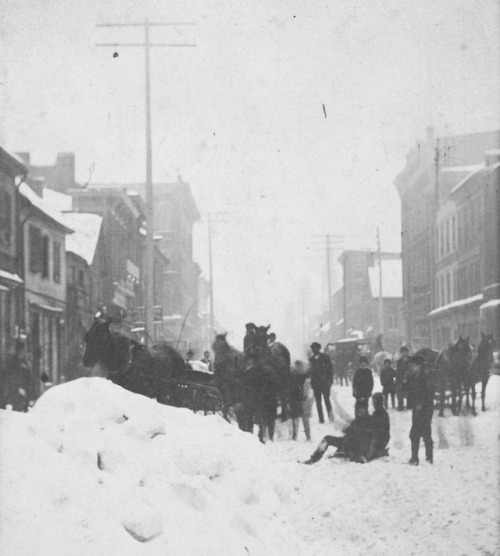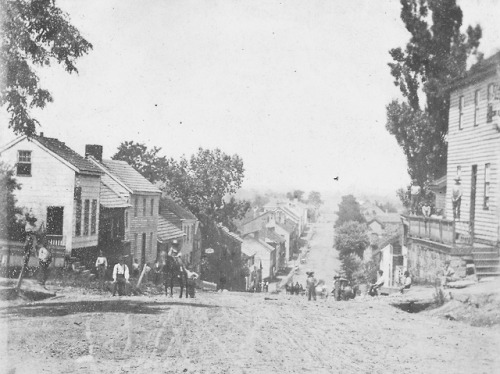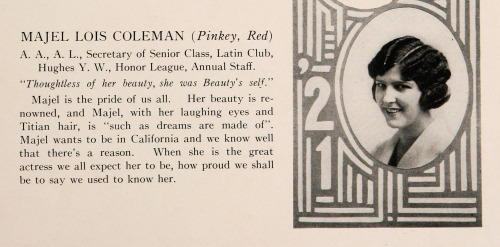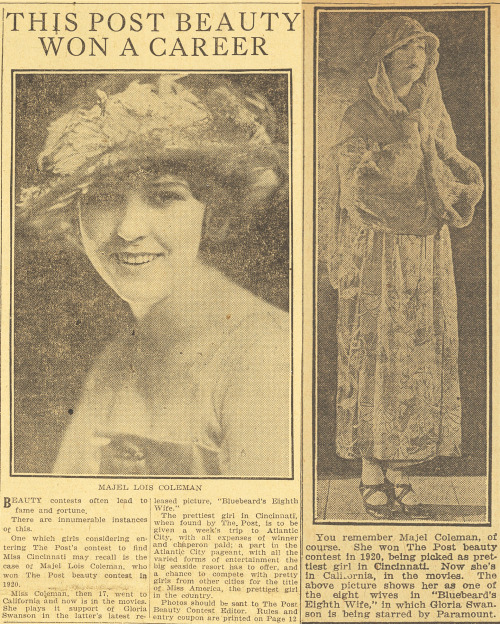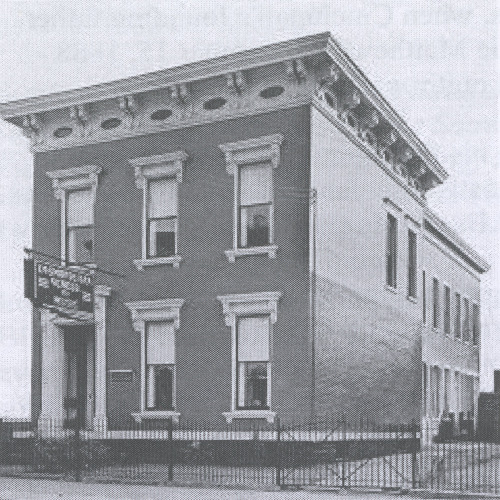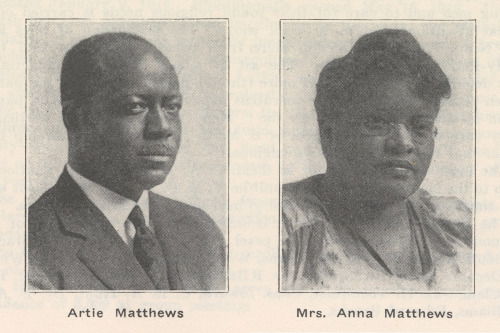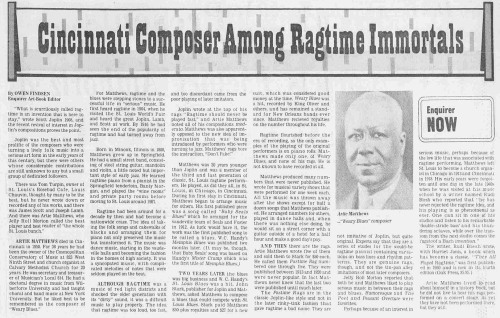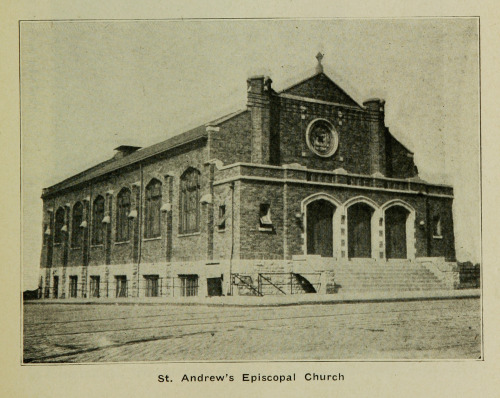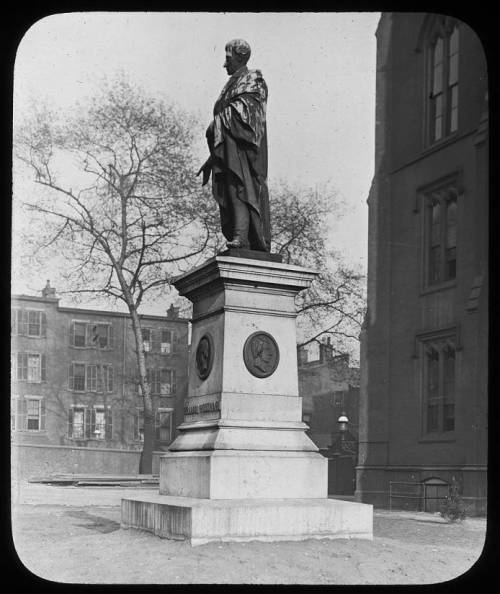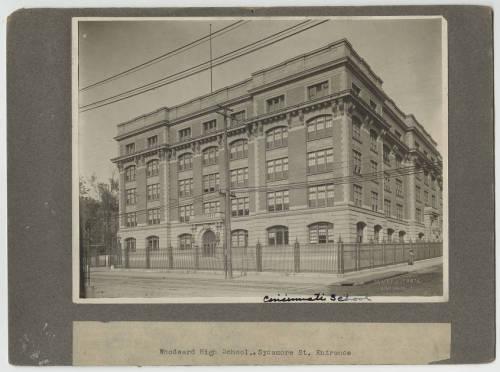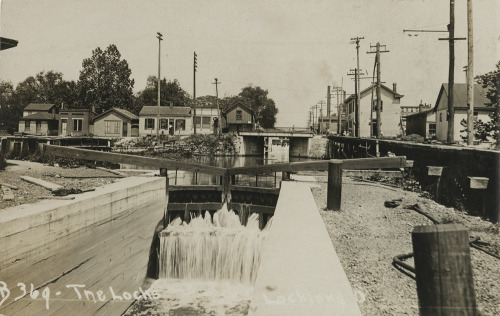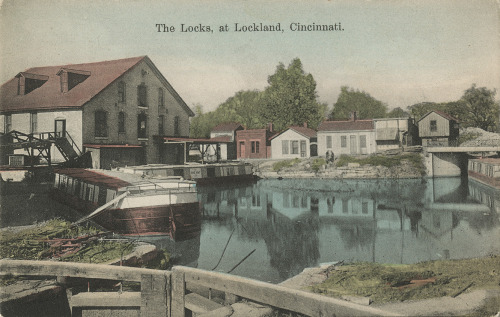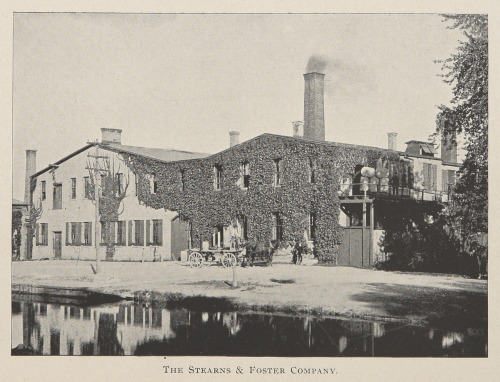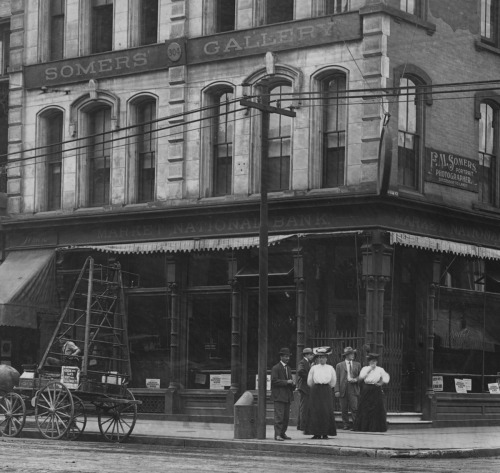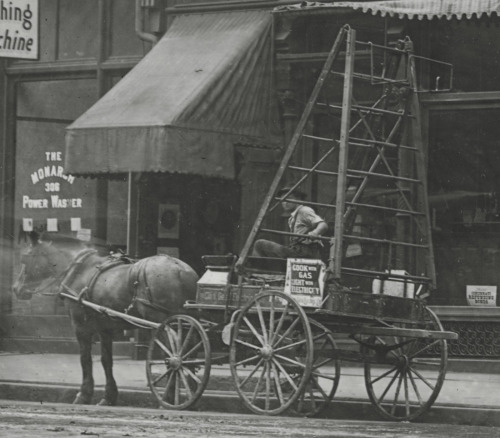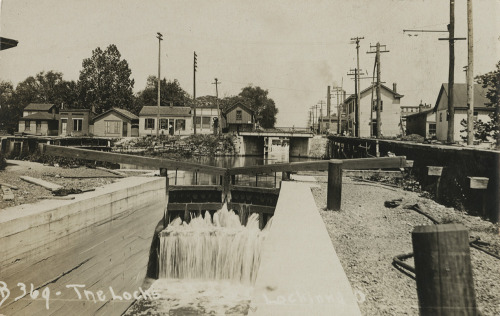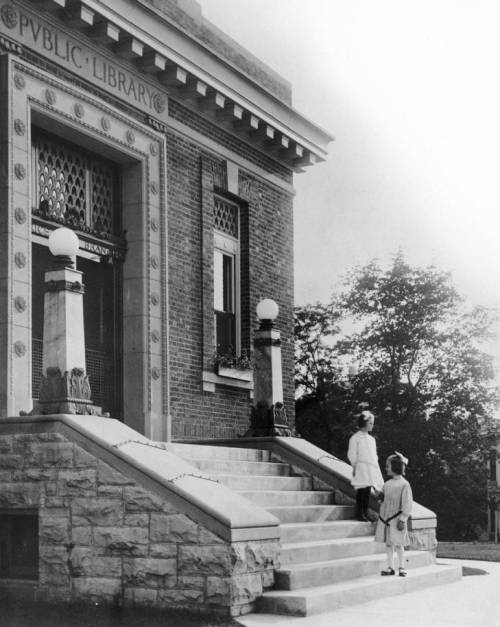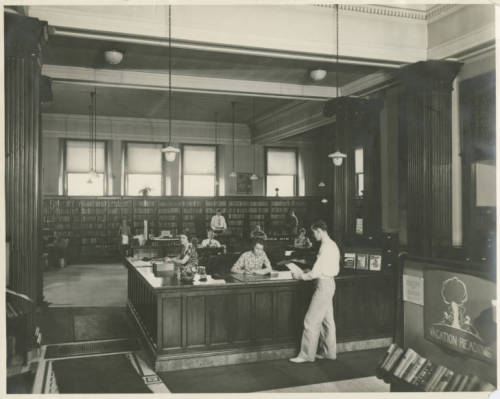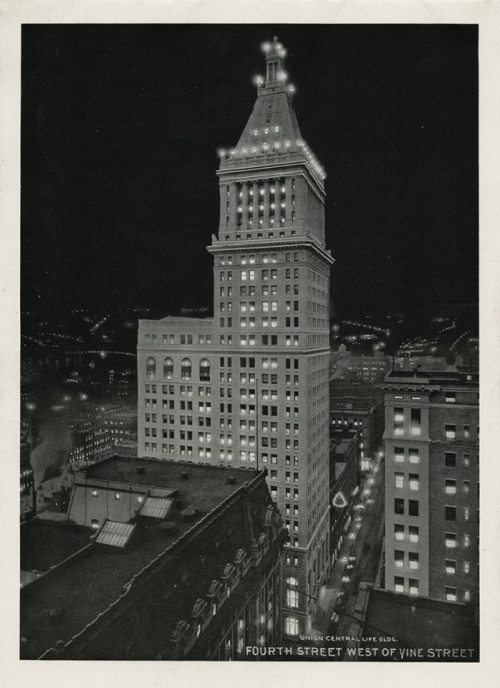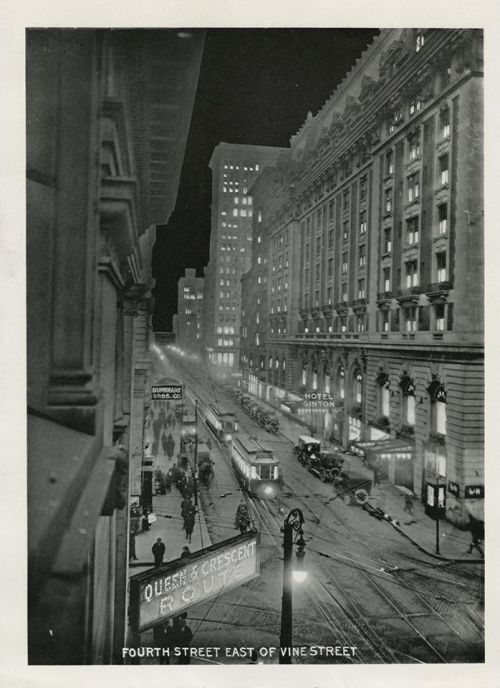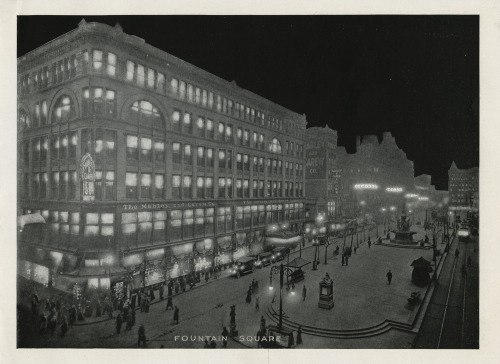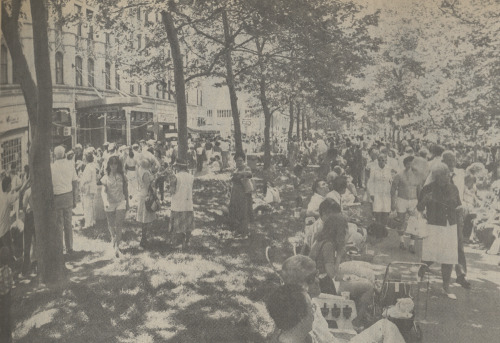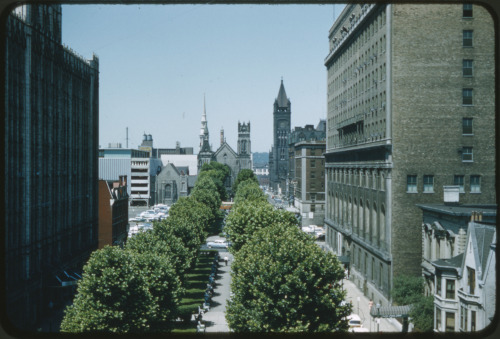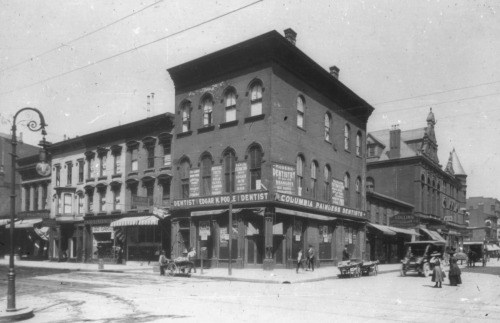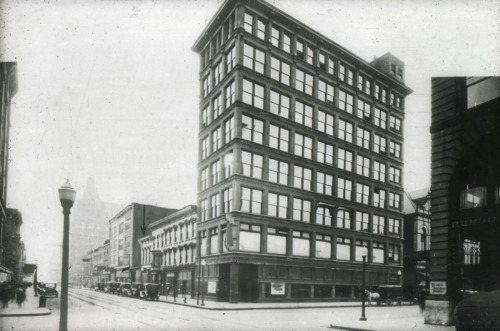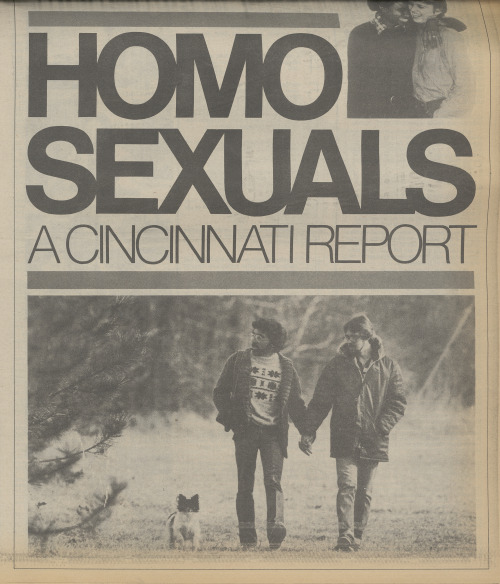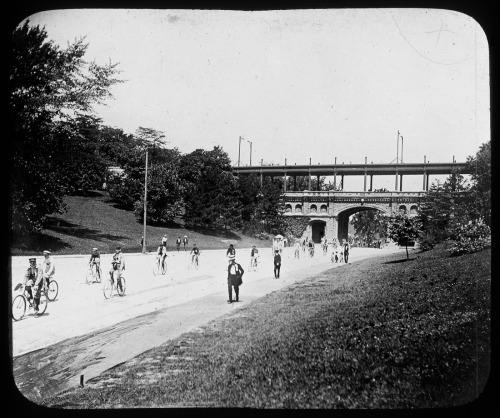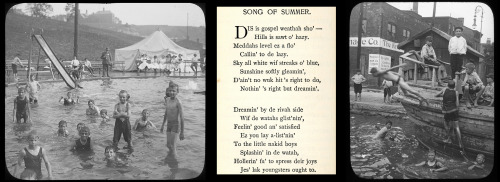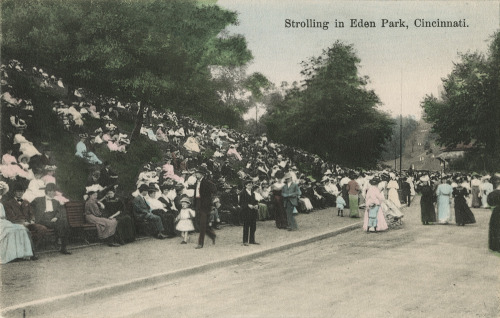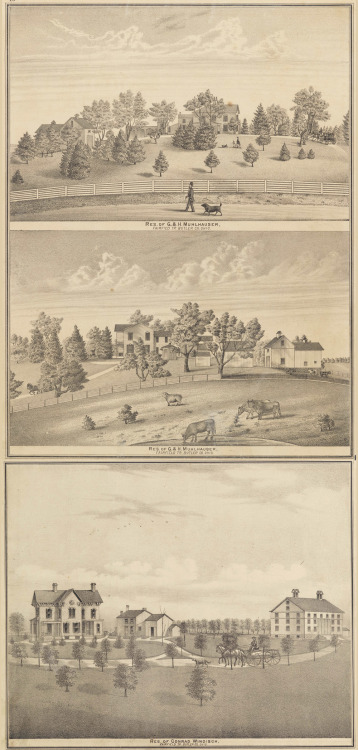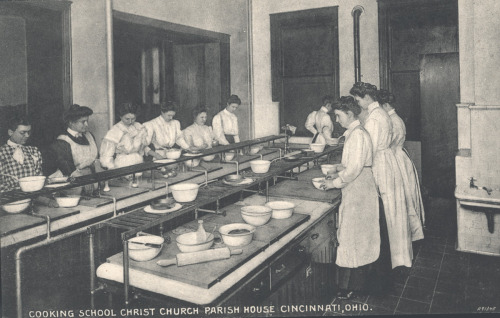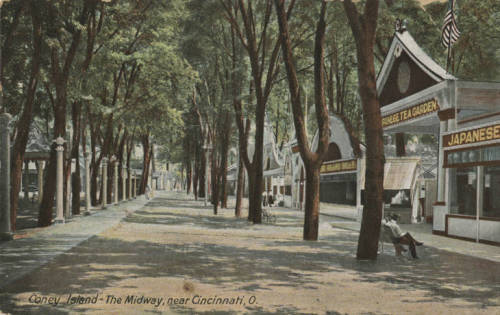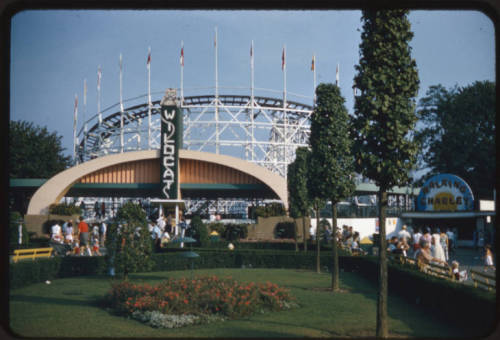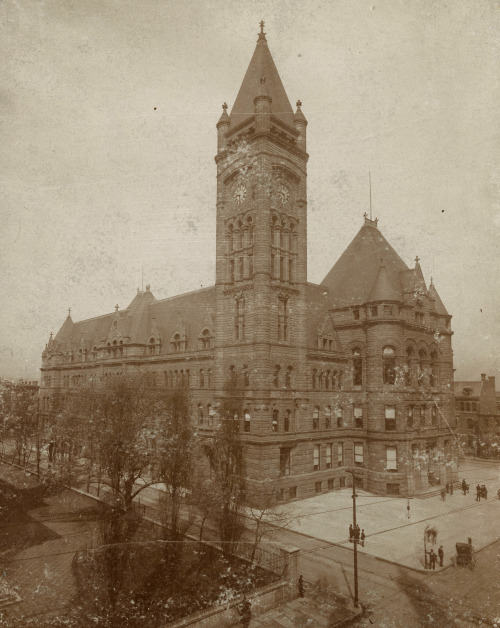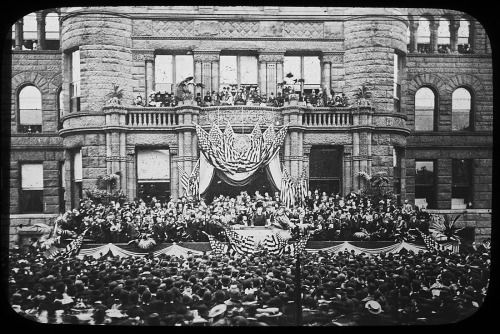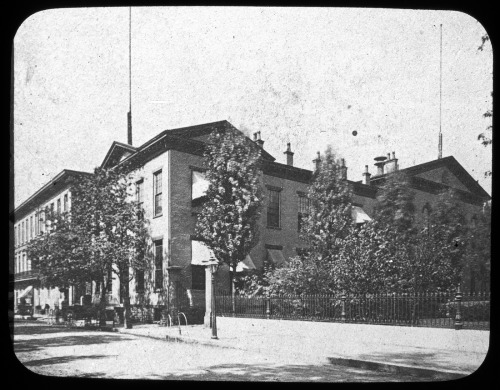#ohio history
Portrait of a group posing in a street after a snowstorm in Steubenville, Ohio, c. 1880′s. By D. Filson and Son.
Source: New York Public Library.
Post link
View of people posing along a street in Richmond, Ohio, c. 1880′s. By photography firm D. Filson and Son.
Source: New York Public Library.
Post link
Majel Coleman was Cincinnati girl born in 1903. Her family lived in various areas around the city, including Avondale. Her father was Pierce Devon “Percy” Coleman, a baseball pitcher from Mason. He mostly pitched for St Louis but did pitch for the Reds for a single game in 1898. He also pitched for several minor league teams. After baseball, he worked as a traveling paint salesman.
Coleman had already received an acting contract offer at 16 when a playwright saw her on a train, but her mother insisted she finish high school first. She graduated from Hughes High School in 1921 and moved to California with her parents. She starred in several films, mostly for Cecil De Mille, though she never had a starring role. While many of her films are lost she can still be seen in De Mille’s epic King of Kings.
She married Victor Gangelin, a set director best known by his Oscar win for West Side Story. She remained in California until her death in 1980. Curious about other alumni? Want to find more unknown historical figures for Women’s History Month? Check out our Digital Library!
Post link
On January 28, 1856, Margaret Garner, her husband Robert, their four children, and approximately 11 other enslaved people crossed the frozen Ohio River. The Garners sought shelter in Margaret’s uncle’s home along Mill Creek. While in hiding, Margaret’s uncle, worried about how to keep the family safe, left his home to consult with Cincinnati abolitionist Levi Coffin.
Before his return home, U.S. Marshals and slave catchers surrounded and ultimately stormed the home. Faced with seeing her children returned to slavery, Margaret ended her two year old’s life just before being apprehended.
Margaret was held for trial in Cincinnati and abolitionists from across the country came to support her. Abolitionist Lucy Stone spoke at her trial stating, “If in her deep maternal love she felt the impulse to send her child back to God, to save it from coming woe, who shall say she had no right not to do so?”
Margaret was returned to slavery. When Ohio authorities got a warrant for Garner to try her for murder, they were unable to find her. She and her husband, Robert, died in 1858 of typhoid fever in Mississippi. Garner’s story inspired Nobel Prize-winner Toni Morrison’s novel “Beloved”.
See this image and more of Cincinnati’s Black history in CHPL’s Digital Library:
Post link
The Cosmopolitan School of Music was the first Black owned and operated music school in the United States. Established in 1921, musicians Artie Matthews and his wife Anna Howard Matthews provided experience, training and education for hundreds of Black musicians seeking a career in music. The most notable musician to train at the Cosmopolitan School of Music was Frank Foster (1928-2011). Frank composed several pieces for orchestras and jazz ensembles all over the world and won 2 Grammy Awards for his musical arrangements.
Once located at 823 W Ninth Street in downtown Cincinnati, Ohio, the Cosmopolitan School of Music provided a wide range of classes to help Black students develop their musical talent. The classes offered were Language, Expression, Public School Music, Theory, Violin, Voice, Piano, Organ, Band/Orchestra and Ensemble and Natural Dancing.
A quote from W.P. Dabney’s book “Cincinnati’s Colored Citizens” quotes the Cosmopolitan School of Music as “One of its most highly prized privileges is the opportunity to share in the perpetuation and advancement of Black music and art.”
To view W.P. Dabney’s book, CLICK HERE to read it on our Digital Library!
Post link
Reverend Edmund Harrison Oxley Sr. D. D. was born in Trinidad on January 30, 1881. He earned a senior Cambridge certificate at Queens Royal College before immigrating to the United States in 1903. He graduated from Harvard University in 1909, earning prizes in debate and elocution. When Reverend Oxley was called to serve at what was then St. Andrew Mission in 1912 there were 31 parishioners. Through his efforts the mission grew in membership and it became a corporate parish, recognized by the diocese. A new church building was planned and celebrated groundbreaking at 8th and Mound in 1915. Services for the community were also added: a nursery for free child care for working mothers, a free labor bureau and a branch of the Cincinnati Settlement School of music. As a community advocate he also provided leadership on various community committees aimed at providing services for the Black community.
Explore more on our Digital Library!
Post link
Businessman William Woodward opened the first Woodward High School on October 24, 1831. The oldest public-school west of the Allegheny Mountains, Woodward School was located on Sycamore Street in Cincinnati. In the early twentieth century the original building was razed and the new building was rebuilt and opened in 1907. Woodward found a new home in Bond Hill in the 1950s and as of 2006, the City of Cincinnati opened Woodward Career Technical High School. Famous Woodward graduates include President William Howard Taft.
To see more images of Woodward Schools through the years, check out our Digital Library!
Post link
Strategically located on four locks of the Miami-Erie Canal, the village of Lockland was planned in 1828 by Nicholas Longworth and Lewis Howell. The Miami-Erie Canal was a major transportation route from Cincinnati to Lake Erie which attracted a major industry boom in the village of Lockland. Jobs were abundant with the operation of several water powered mills and the Stearns and Foster Company. People were drawn to this more rural area outside of the city of Cincinnati to lay down their roots and call Lockland home.
Be sure to visit our Digital Library to see more Cincinnati neighborhood photographs!
Post link
On the northern coast of Ohio on South Bass Island, the village of Put-in-Bay once had the largest summer resort in the world, the Hotel Victory. Built in 1892 it was a bit too grand and struggled for many of the years it operated. It was 600 feet long and 300 feet deep. It had shops, wine cellars, a barbershop, a pool, a dentist, livery, and ice cream parlor. Most visitors traveled there from railroads or steamboats.
The hotel burnt down in 1919. It had been in financial difficulty for some time and was not rebuilt. The area is now a state park and campground. Some of the ruins are still visible.
Curious of other historical hotels? Check out our Digital Library!
Post link
Designed by Samuel Hannaford, the H. W. Derby Building has served as a bank and a photography studio, and is listed in the National Register of Historic Places.
This Italianate building was built in 1887 by publisher and bookseller H. W. Derby. The original “Derby Building” stood at the Southwest Corner of Third and Walnut Streets. Derby made a fortune selling Law books and other educational materials.
Be sure to visit our Digital Library to see more historic Cincinnati buildings.
Post link
Strategically located on four locks of the Miami-Erie Canal, the village of Lockland was planned in 1828 by Nicholas Longworth and Lewis Howell. The Miami-Erie Canal was a major transportation route from Cincinnati to Lake Erie which attracted a major industry boom in the village of Lockland. Jobs were abundant with the operation of several water powered mills and the Stearns and Foster Company. People were drawn to this more rural area outside of the city of Cincinnati to lay down their roots and call Lockland home.
Be sure to visit our Digital Library to see more Cincinnati neighborhood photographs!
Post link
Businessman and philanthropist Andrew Carnegie donated and built over 2,500 libraries worldwide between 1883 and 1929. The state of Ohio is ranked fifth in the nation for its number of Carnegie libraries with Cincinnati originally boasting nine libraries total. Today, Cincinnati and Hamilton County Public Library are still operating seven Carnegie branches. Our current Carnegie branches include: Avondale, Corryville, Hyde Park, Northside, Norwood, Price Hill and Walnut Hills. Cincinnati’s first Carnegie to open was Walnut Hills branch in 1906, with the others following soon after. Walnut Hills branch is currently part of Building the Next Generation Library plan and will see many updates including more square footage and greater accessibility.
To see more updates on the Walnut Hills branch, check out https://bit.ly/3BFoPZl
And, to view more historic images of our Carnegie branch libraries, visit our Digital Library!
Post link
Check out this selection of unique photographs from the book “Night in Cincinnati,” by Theodore Newcomb, published in 1915.
Be sure to visit our Digital Library to view more Cincinnati history and unique finds!
Post link
Swimmers used to flock to the Ohio River to beat the heat. Kentucky had several popular sandy bathing beaches across the river. In 1904, the beaches around Cincinnati could get up to 20,000 people a day. There were multiple community water parks as well—not just Coney Island.
See more pictures of historical swimming spots in our Digital Library!
Post link
Piatt Park, located on Garfield Place between Vine St. and Elm St. in downtown Cincinnati, is one of the city’s oldest parks. The land was donated to the city for public use, for ‘market space’, in 1817 by John H. and Benjamin M. Piatt. It was never developed as a market and within a few years it was being used as a park. On October 21, 1940 it was dedicated as Piatt Park in honor of the donors.
Be sure to check out our Digital Library!
Post link
The streetscapes of Cincinnati are always changing. Businesses come and go, old buildings are torn down, and new ones are built.
Top Image:
In 1895, the northwest corner of 7th and Race Streets was dominated by “The Columbia Painless Dentists, which was run by Dr. Edgar M. Poole . One of the large signs posted on the outside of the building reads "Painless Extractions with cocaine air or gas”.
An advertisement for the business placed in a 1907 edition of the Cincinnati Post reads:
“Oftentimes, inspection is forced of the teeth. This is wrong. The teeth should be examined frequently for signs of decay and given the proper attention. We will fill them for 50 cents or extract them painlessly. Our prices are the most reasonable. Call and see.”
The Collins and Bruggemann Co. Art Store can be seen in the one-story building to the right of Columbia Dentists, under a sign that reads “ Collins and Bruggemann Pictures and Frames”. The business moved to 4th street when these building were torn down.
The distinctive Lincoln Club building can be seen at the far end of the block on 8thStreet.
Visit our Cincinnati History Slide Collection to see more images like this.
Middle Image:
Located on the corner of Race and 8th, the Lincoln Club of Cincinnati was a Republican social organization. Founded in 1879, the club counted many prominent citizens as members, including Charles Fleishmann, who served as a Vice President, and William Howard Taft.
Their headquarters building at 8th and Race was built in 1886, and designed by Samuel Hannaford.
The three story neo-Romanesque structure was remodeled in 1895. After the Lincoln Club folded, the Rudolph Wurlitzer Company purchased the building and leased space to the Cincinnati Automobile Club. The building was razed in 1929, and the site remained a parking lot until the Garfield Tower was built in the late 1960’s.
This image is from Kraemer’s picturesque Cincinnati.
Bottom Image:
The northwest corner of 7th and Race Streets in 1921. Originally known as the Robertson Building, this 8-story building was built circa 1910 by the Robertson Realty Company at a cost of $90,000. In 1911 it was sold to Jefferson Livingston, the owner of the Snyder Preserve Company, who renamed named the building after himself. The Pearl Market Bank purchased the entire Livingston Block for $325,000 in 1921.
View the original slide image here.
Post link
In this month of celebrating Pride, we highlight LGBTQ+ history and representation in Cincinnati.
In the late 1970s the Greater Cincinnati Gay Coalition, later renamed the Greater Cincinnati Gay and Lesbian Coalition (GCGLC) was formed as a parent organization to other LGTBQ+ organizations throughout the city. This created a safe space for people to come and share personal stories, organize events and support each other’s efforts. The GCGLC along other organizations such as PFLAG and Stonewall Cincinnati, just to name a few, were responsible for the Cincinnati Pride we know today.
It should be noted that the Transgender community as well as BIPOC are drastically underrepresented and supported in the LGBTQ+ community. It wasn’t until recently that Transgender people and BIPOC have gained wider acceptance and representation within the United States.
The Crazy Ladies Bookstore was a hotspot in the LGBTQ+ and Feminist community. Named as a commentary on women being belittled by being deemed as “crazy” or “hysterical”, it was a safe haven for individuals to meet and gather resources to create lasting change in society.
One year after the establishment of the Cincinnati’s first LGBTQ+ organization, Cincinnati held its first Pride Parade in April, 1973. Roughly 400 people attended the parade and despite press releases, there was little to no media coverage of the parade. The Independent Eye (as shown above) and Channel 9 news were the only coverage the parade received. After the parade, there was a dinner and dancing to celebrate the significance of the event.
Pride parades are held all over the world to commemorate the Stonewall riots which sparked the LGBTQ+ movement.
Click here to see this article as is appears in the Independent Eye.
In 1982, The Cincinnati Enquirer ran a 27-page special titled “Homosexuals: A Cincinnati Report.” Editors noted that it was “an attempt to provide a context to understand the lives of perhaps 140,000 Cincinnatians who were gay.” Despite public backlash, a piece of this length in a well-known newspaper was unheard of in 1982. However, it provided the LGBTQ+ community the much needed visibility they deserve.
Click here to view the full 27-page special.
Be sure to visit our Digital Library to view more Cincinnati history! Happy Pride!
Link to LGBTQ+ resources and support groups.
Post link
The current village of St. Bernard was first settled by John Ludlow in 1793. By 1850, John Bernard Schroeder purchased and auctioned 90 lots, naming the area St. Bernard. By 1912, St. Bernard incorporated as a city with more than 5,000 residents. Home of Proctor and Gamble’s Ivory Soap as well as other manufacturing companies put St. Bernard on the map as an industrial power. As jobs multiplied so did the areas residential growth.
To view more of St. Bernard’s history check out our Digital Library.
Post link
Summer is here and we are eager to enjoy the warm weather and have fun outdoors. Cincinnatians have many wonderful parks and waterways to choose for outdoor recreation. Enjoy these images from our Digital Library of summer fun in and around the city.
Post link
The Mühlhäuser brothers Gottleib and Henry were successful businessmen when they teamed up with their brother-in-law and experienced brewer Conrad Windisch, to form the Windisch-Muhlhauser Company and Lion Brewery around 1867. They built an extensive set-up of brewery, bottling, storage, and delivery in Over-the-Rhine near West Liberty and the canal. It grew to be the second largest producer in town and was the king of local sales.
The brewery stayed in the family—the Mühlhäuser and Windisch sons had leadership positions in the company. But they were hit hard by prohibition. After an attempt at making alcoholic alternatives the family sold it off and focused their efforts on their farm instead. There was a brief revival post-prohibition, but Lion Brewery shut down for good in 1934. The remaining beer was dumped into the canal.
Curious about Cincinnati’s brewing history? Check out our Digital Library!
Post link
Founded in 1817, Christ Church was the first Protestant Episcopal church in Cincinnati. Founded by a group of prominent citizens that included future president William Henry Harrison, and Dr. Daniel Drake, the church is one of the City’s oldest institutions.
Here is a brief history of the church, as excerpted from the 1888 publication “The centennial review of Cincinnati: one hundred years”:
"The first Protestant Episcopal church in Cincinnati was organized through the efforts of Rev. Philander Chase, afterward Bishop Chase, at a meeting held at the house of Dr. Drake, at which the parish was organized with twenty-two members, including General Harrison, Griffin Yeatman, Harvey St. Clair, Jr., Dr. Drake, Jacob Baymiller and other prominent citizens of that day. The first meeting was held in the cotton factory on Lodge Alley, between Fifth and Sixth streets, and afterward in several buildings, the Rev. Samuel Johnson being the minister, and in I8I8 the Baptist building on West Sixth street was secured for the services, and was afterward bought by the church. In 1821 the church was regularly incorporated under the title of the Episcopal Society of Christ Church, and remained under the rectorate of Rev. Mr. Johnson until 1828, when he went to the newly organized parish of St. Paul’s, and was succeeded in Christ Church by the Rev. B. P. Aydelott. In November, I833, the lot now occupied by Christ Church, on the north side of Fourth street, between Sycamore and Broadway, loo X I30 feet in area, was bought for $9,000, upon which was built the structure still used by the church, the plan of the old Stepney Church, one of the notable parish churches of London, being adopted as a model. There are now seventeen churches of this communion in the city.”
Explore more Cincinnati history by clicking HERE to access our Lantern Slides Collection on our Digital Library!
Post link
In 1886, apple-farmer, James Parker sold 20 acres of land along the Ohio River. By June, the Ohio Grove Corporation opened “Ohio Grove, The Coney Island of the West” to the public. Since its original opening, Coney Island has been through various changes over the years. Civil Rights activists including Cincinnati’s Marian Spencer fought to have Sunlite Pool desegregated in 1955. Riverbend Music Center was added in 1984 as an outdoor concert venue and by 2019 the amusement rides were being sold off to accommodate upgrades for Sunlite Pool.
To see more historic images of Coney Island visit our Digital Library!
Post link
One of the most iconic structures in Cincinnati is City Hall. The Richardson Romanesque style of architecture, designed by Samuel Hannaford (who designed Music Hall), contains four and a half stories and a nine story clock tower. This one of a kind building earned its place in the National Register of Historic Places in 1972. Scroll through the images below to learn more about City Hall.
Click the link below to visit our Digital Library and learn more about Cincinnati’s historical buildings.
https://digital.cincinnatilibrary.org/digital/
Post link

“FEUD IS RESULT OF A REFUSAL TO KISS BABY
Whole Section in Trouble Because of Unappreciative Man with Grouch
COMMUNITY TAKES SIDES
Bill Dunham Open in His Declaration That Ollie Kebler Shall Yet Beg for Privilege He Scornfully Refused–Kebler Had Loved Pretty Little One’s Mother, and There is the Root of the Whole Trouble–Fight So Far Has Been Interesting, with Further Developments Expected”
~The Rising son. (Kansas City, Mo.), 23 Feb. 1907. Chronicling America: Historic American Newspapers. Lib. of Congress.
[The article is actually very long but I think this clipping sums it up sufficiently.]

This post, including the image above, comes from Karmen Beecroft, Digital Projects Librarian for Digital Initiatives at Ohio University. I’ve put in a cut, so make sure you click through to read the entire post!
The eleventh of twelve children and the youngest daughter, Anne Claire Keating was born to Irish immigrant parents on February 25th, 1879 in Terre Haute, Indiana. Her father Edward, a stone mason—and “artist in marble” according to one newspaper– had arrived on American shores some eighteen years previously, at the beginning of the Civil War.(1) In Missouri, he met and soon married Ellen Cadden, herself a childhood transplant from the Emerald Isle. Half of Ellen’s children would die in the coming decades, but stalwart Anne seldom left her mother’s side.
Then known as Anna, Keating graduated Terre Haute High School in 1897 and immediately enrolled in the nearby Indiana State Normal School, which she attended until 1899. At the turn of the century, she dropped out to become Second Assistant Librarian under the direction of Arthur Cunningham, founder of the Normal School library. In 1901, Keating received a promotion to first assistant librarian, a position she would continue to hold for another two decades—minus a leave of absence from September 1907 to June 1908 to complete her library science degree at the Pratt Institute in New York. During that period, she lived in a Brooklyn boardinghouse while also attending the Brooklyn Institute as a “special student.” Her married sister Margaret lived nearby, helping her settle in and attending her when a sudden “nervous affection” which “made it painful for her even to dress her hair” kept her out of school for two days.(2) In the coming years, the two would several times vacation together on the coast for extended periods in service to Keating’s health.
Upon completing her degree, Keating returned to her parents’ home in Terre Haute, which she also shared with her widowed sister Mary. Her father and eldest brother both died in 1913; the three women moved out of the family home soon after. As president of the Terre Haute Women’s Club and patroness of the Alpha Section of the Normal School Women’s League, Keating frequently made the local papers while promoting educational lectures and mentoring her younger sorority sisters. At the library, she assumed the duties of cataloger during a period of great expansion while somehow also finding time to pursue graduate coursework at the University of Wisconsin. A satirical student publication issued around this time sketches the scene at the Normal School library in a few lines:
Misses Marshall, Keating, Darrow and Brown,
Cunningham’s satellites, and ne’er do they frown;
Four good varieties, thick, fat, and thin;
At five o’clock, mornings, their work it begins.(3)
At the age of 42, it seemed as though Keating had finally gotten her big break when a position opened up as head of the Muncie branch of the Normal School library. “I anticipate a very pleasant time at Muncie,” she told the Terre Haute Saturday Spectator. However, Keating’s mother died while preparing to make the move, derailing her ambitions; Keating remained in Terre Haute. Four years later, another opportunity for advancement arrived hand-in-hand with personal tragedy. In January 1925, her six-year-old niece Frances, of whom she had partial custody, developed acute laryngitis while in her aunts’ care and died suddenly. Several months later, Keating, then 46, left her family and hometown to assume the position of Ohio University Librarian in the small Appalachian town of Athens, some 350 miles east of Terre Haute.
Keating, the university’s third Librarian and the first woman to fill that role, arrived at Athens with an agenda. The Green and White, Ohio University’s student newspaper, reported that
the very smell of the paint and varnish used in the library redecoration attests to the initiative and leadership of the new librarian. Several changes in location and library procedure have already been announced, and are now being planned and executed. Stacks privilege[s] to be granted to students soon[; this] comes from Miss Keating’s effort to make the library more useful and attractive.(4)
Keating immediately embarked upon an ambitious remodeling plan for the crowded Carnegie Library, including “a new reference room and more commodious reading room,” as well as “a better and more complete children’s room.” In 1925, Keating’s charges numbered just 50,000 books and four assistants.
Echoing her Terre Haute occupations, Keating swiftly moved to embed herself in the Athens university culture, becoming first secretary and later president of the OU chapter of the American Association of University Women. A dedicated patroness of the Theta Phi Alpha sorority, she often collaborated with popular Dean of Women Irma Voigt to facilitate student programming and provide mentorship. An enduring autodidacticism led Keating to pursue a fifth course of study at George Washington University and by 1931 she had added a Bachelor of Arts degree to her ever-growing portfolio.
1931 also saw the completion of the Edwin Watts Chubb Library and the transfer of the Carnegie stacks—now housing 70,000 volumes—to the new building. Chubb Library provided space for some 240,000 books and 600 simultaneous readers, a threefold increase over the study space available at Carnegie. Head counts conducted by Keating’s staff revealed that the new library received 20,000 visits a month during the opening years of the Great Depression, a great increase over usage patterns observed in the 1920s. The incoming university president Herman James dealt the Library’s newfound popularity a blow, however, when he directed that Keating’s decade-long open stacks policy be discontinued. “It is felt that lower classmen are not ready for undirected browsing among so many volumes,” Keating reservedly reported to The Green and White. “They must first be educated for this responsibility.” (5) The closed stacks mandate proved extremely unpopular in subsequent years, though Keating noted in exasperation that only half the senior class ever reported to receive their passes. Nevertheless, she continued to remove barriers when able, adding a fiction-heavy open shelf collection just a semester after James’ announcement.
In 1937, Keating returned to her Normal School roots with the development of a 3-credit course for prospective educator-librarians. Keating tartly noted that her class—the first in school library administration offered by a state university in Ohio– “in no sense prepares the student for full time librarianship.”(6) Though enrollment varied, Keating continued to offer the course for twelve years until her retirement in 1949 at the age of 70.
Over the 24 years of her tenure at OU the student body as a whole grew 400%. Keating reacted by growing the collections to 180,000 volumes and increasing her staff to 12 assistant librarians and three clerical assistants. An army of fifty student workers sprang up to deal with the closed stacks system and increased circulation. Keating’s retirement coincided with that of Dean Voigt, her longtime collaborator. The Ohio Alumnus hinted at intriguingly unspoken controversies during their long careers: “both women were in positions in which it was impossible to please all person having dealings with them. There are doubtless those who do not agree with some of their actions and decisions. But, many fewer, we’ll warrant, is the number who do not credit them with an earnest desire to deal fairly in the matters within their wide jurisdictions.”(7)
Upon quitting Athens, Keating joined her sister Margaret in Croton-on-Hudson, New York, until Margaret’s death in 1952. At the age of 73, Keating returned for a last time to Terre Haute to live with her widowed sister-in-law Clara. A few months later, Keating herself died of heart disease. From “Cunningham’s satellite” to university administrator, Anne Keating’s life is one of conflicting drives and stymied ambitions finally realized. As an unmarried daughter, her responsibilities were culturally prescribed by the needs of the family, even as her remaining family members assumed responsibility for her welfare later in life. She never let these pressures constrain her mind, however—during the 26 years she served at the Normal School library, she pursued coursework through three different universities and sought continually to further her education through reading and lectures. At Ohio University, her evenhanded management saw her library safely through the Great Depression and World War II. Though she personally disliked publicity, “Miss Keating’s” legacy is indeed a very public one—the modern library system she founded, with its emphasis on pedagogy and usability, forms the basis of our institution today.
Notes
1 Terre Haute Saturday Evening Ledger [Terre Haute, IN] 2 April 1881: 8.
2 Terre Haute Sunday Spectator [Terre Haute, IN] 16 November 1907
3 Denehie, Elizabeth. “A Eulogy on our Faculty.” Normal Advance [Terre Haute, IN] June 1915: 309.
4 “Introducing Miss Keating.” The Green and White [Athens, OH] 9 February 1926: 1.
5 “New Library Rules Issued.” The Green and White [Athens, OH] 27 September 1935: 1.
6 The Green and White [Athens, OH] 26 February 1937: 4.
7 Williams, Clark E. “From the Editor’s Desk” The Ohio Alumnus [Athens, OH] May 1949: 2.

